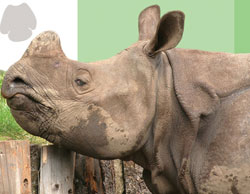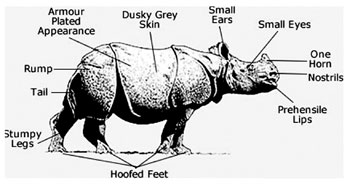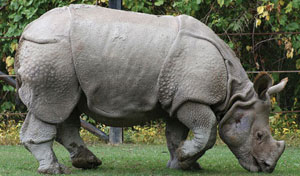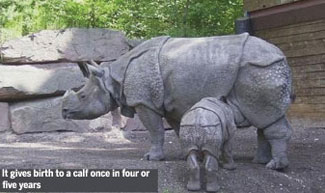Nature Trail
Javan Rhinoceros:
Most endangered large mammal
The World Wildlife Fund (WWF) recently declared the 10 animal species
on the brink of extinction and the Junior Observer featured a graphic of
them in the back cover, last week. Among these animals who are faced
with the possibility of being wiped out of the Earth completely is the
Javan Rhinoceros.
 A member of the family Rhinocerotidae and one of the five species of
rhinoceros still existing, it belongs to the same genus as the Indian
Rhinoceros. The genus name Rhinoceros is derived from Greek: rhino
meaning nose and ceros meaning horn. It is also known as the Lesser
One-Horned Rhinoceros (Rhinocerus Sondaicus) and Sunda Rhinocerus. A member of the family Rhinocerotidae and one of the five species of
rhinoceros still existing, it belongs to the same genus as the Indian
Rhinoceros. The genus name Rhinoceros is derived from Greek: rhino
meaning nose and ceros meaning horn. It is also known as the Lesser
One-Horned Rhinoceros (Rhinocerus Sondaicus) and Sunda Rhinocerus.
Once, the most widespread of Asian rhinoceroses, the Javan Rhinoceros
(which ranged from the islands of Indonesia throughout Southeast Asia
and also into India and China), is now found only in Indonesia and
Vietnam.

There are two known popularities of this critically endangered
species in the wild; about 40 to 50 are known to live in Kulon National
Park on the island of Java in Indonesia and about 10 or even a lesser
number, in Cat Tien National Park in Vietnam.
It is historically known to have inhabited lowland rain forests, wet
grasslands and large floodplain in the wide range it once lived.
Poaching for its prized horn and loss of habitat are the two main
reasons for the decline of this large mammal which is now labelled as
the “rarest and most endangered large mammal on Earth’.Most of you must
have seen a rhinoceros in the zoo, but the Javan rhino, though very
similar in appearance, has many differences.
It is smaller in size than its cousin, the Indian Rhinoceros which is
also known as the Greater One-Horned Rhinoceros.
The body to head length of the Javan rhino is about 3.1 to 3.2 m (10
to 10.5 feet). It can reach a height of 1.4 to 1.7 m (4.6 to 5.8 feet).
As you are aware that rhinos are generally huge animals, it may not come
as a surprise to learn that the Javan rhino, even though smaller than
the Indian species we are familiar with, weighs between 900 and 2,300 kg
(2,000 and 5,100 lb).
 The rhinos in Java appear to be significantly smaller in size than
those found in Vietnam according to scientists. Like its Indian cousin,
the Javan species two has only a single horn (the other species have two
horns). The rhinos in Java appear to be significantly smaller in size than
those found in Vietnam according to scientists. Like its Indian cousin,
the Javan species two has only a single horn (the other species have two
horns).
The Javan rhino’s horn is the smallest horn among all rhinos,
generally about 20 cm (7.9 inches) in length. The longest horn recorded
from this species was only 27 cm (10 1/2 inches).
 Even though the rhinos are known to use their horns in combat, the
Javan rhino does not appear to often use its horn for fighting. However,
it uses its horn to scrape mud away in wallows to pull down plants when
it wants to eat, and also to open up paths through the thick vegetation
it moves about in. Even though the rhinos are known to use their horns in combat, the
Javan rhino does not appear to often use its horn for fighting. However,
it uses its horn to scrape mud away in wallows to pull down plants when
it wants to eat, and also to open up paths through the thick vegetation
it moves about in.
The Javan rhino’s skin is very different from that of the other
rhinos. The hairless, splotchy gray to gray-brown skin falls in folds in
the shoulder, back and rump area. The natural mosaic pattern gives the
rhino an armoured look. The neck folds which form a saddle shape are
smaller than that of its Indian cousin.
There are three distinct subspecies but only two of them are known to
exist.They are the Indonesian Javan Rhinoceros (Rhinoceros sondaicus
sondaicus) Vietnamese Javan Rhinoceros (Rhinoceros sondaicus annamiticus)
and the Indian Javan Rhinoceros (Rhinoceros sondicus inermis). The
latter is believed to have become extinct in the first decade of the
1900s.
 The name inermis (which means unarmed) has been given to this species
because of the distinctive small horns in males and evident lack of it
in females.Like all rhinos, the Javan rhino too has a good sense of
smell and hearing, but its vision is rather poor. The name inermis (which means unarmed) has been given to this species
because of the distinctive small horns in males and evident lack of it
in females.Like all rhinos, the Javan rhino too has a good sense of
smell and hearing, but its vision is rather poor.

The Javan rhino has a long, pointed prehensile upper lip which aids
the animal in grabbing its food. It is a herbivore which survives by
eating diverse plant species, especially the shoots, twigs and the
tender leaves.
It also eats fallen fruits. Would you believe that the rhino eats an
estimated 50kg (110 lbs) of food daily? And, unlike most animals, the
rhino needs salt in its diet.
So, as salt licks (places where animals lick salt from the ground)
normally found in its natural range are not found in Ujung Kulon park,
the rhinos have been observed to drink sea water, most likely to meet
the nutritional need.The Javan rhinos are solitary animals with the
exception of breading pairs and mothers with calves.
They are seen in small groups only near salt licks and mud wallows.
All rhinos love to wallow in mud because this activity allows them to
maintain a cool body temperature. It also helps to present diseases and
parasite infestations.
You may have observed cattle, especially buffaloes and elephants
wallowing in mud.The females reach maturity at three to four years of
age while the males mature at six years. After a gestatation (pregnancy)
period of about 16 to 19 months, the female gives birth to a calf.
The calf is weaned at around two years. The female will produce
another calf only after about four to five years. This low birth rate is
having an adverse impact on the population and we humans two are making
it impossible for this animal to exist on this Earth by killing it and
destroying its habitats.
| Fact file
*Rhinoceross have no predators in their range other than humans.
*The Indian and Javan Rhinosceros first appeared in the fossil record
in Asia around 1.6 million to 3.3 million years ago.
*The lower incisors are long and sharp and it uses these teeth when
its fighting.The two rows of six low-crowned molars located behind the
incisors are used to chew coarrse plants.
*It is the most adaptable feeder of all the rhinos. If large trees
are not available in the areas it noams, the Javan rhino knocks down
saplings to reach its food.
*The Javan rhino is the least studied of all rhino species.
Scientists and conservationists rarely study the animal directly not
only because they are extremely rare, but also because of the danger of
interfering with this highly endangered species.
The first studies by naturalists from outside of its range had taken
place in 1787, but the Dutch naturalist, Petrus Camper who studied the
skulls of the rhinos had died in 1789 before publishing his discovery
that the Javan rhinos were a distinct species.
*The Javan rhino usually avoids people, but will attack when
confronted.
*It does not dig its own mud wallows, but prefers to use those dug by
others or use naturally occuring pits.
The rhino horns have been a traded commodity in China for over 2,000
years be cause it’s believed in traditional Chinese Medicine that the
horns have healing properties. |
|

